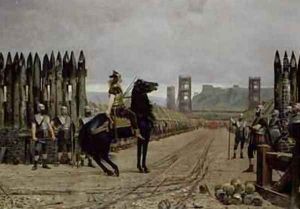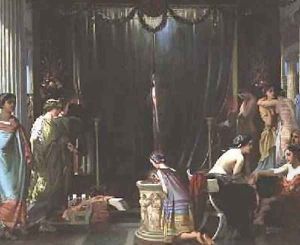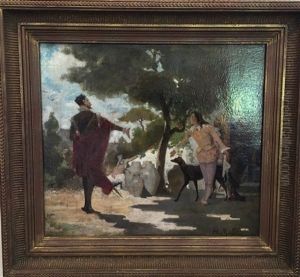Henri Paul Motte Paintings
Henri-Paul Motte was a French artist born on December 12, 1846, in Paris. He was known for his historical paintings, particularly those depicting scenes from ancient history and mythology. Motte was a student of the renowned history painter Jean-Léon Gérôme, who was a prominent figure in the French academic art scene of the time. Under Gérôme's tutelage, Motte developed a meticulous approach to painting, with a strong emphasis on historical accuracy and detail.
Motte's interest in history was reflected in his choice of subjects, which often involved dramatic and monumental events. He gained recognition for his ability to bring these scenes to life with vivid detail and grandeur. This was a period in which history painting was highly valued for its educational qualities as well as its ability to instill a sense of national pride and identity. Motte's works fit well within this tradition, and he contributed to the genre with works that were praised for their visual impact and historical fidelity.
Throughout his career, Motte exhibited his works at the Paris Salon, the official art exhibition of the Académie des Beaux-Arts in Paris. His paintings often received positive reviews and were appreciated by critics and the public alike for their visual storytelling and technical skill. Some of his notable works include 'The Fiancée of Belus' (1885) and 'Vercingetorix Throws Down His Arms at the Feet of Julius Caesar' (1899), the latter being particularly famous for its portrayal of the defeated Gallic leader in the presence of Caesar after the Battle of Alesia.
Henri-Paul Motte's contributions to French academic painting were significant during his lifetime, though he did not achieve the same enduring fame as some of his contemporaries. Nevertheless, his works continue to be studied and appreciated for their historical content and artistry. Motte's approach to painting was characteristic of the academic style of the late 19th century, which would later be challenged by the avant-garde movements of the early 20th century.
Motte passed away on April 21, 1922, in Paris. Although his name may not be as widely recognized today as some of his peers, his paintings remain as testaments to the skills and interests of academic painters of his era, capturing the grand narratives of history with a meticulous brush and a keen eye for detail.











